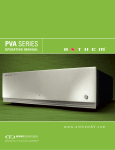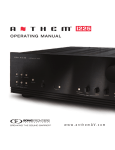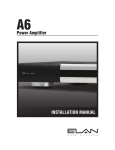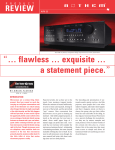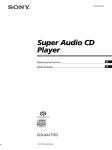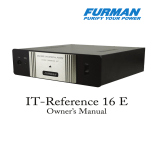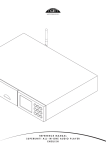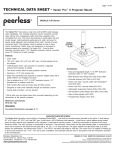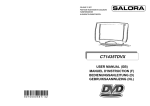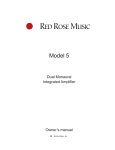Download Rotel Dolby Pro Logic Surround Pream Specifications
Transcript
EQUIPMENT REPORT SURROUND-SOUND PREAMPLIFIERPROCESSOR/TUNER & 7-CHANNEL POWER AMPLIFIER Sonic Frontiers Anthem AVM 20 & Anthem PVA 7 T hings move pretty fast in the surround-sound preamp-processor market. When I first saw the Sonic Frontiers Anthem AVM 2 a year or so ago, I thought it looked like an interesting product, so I gave Sonic Frontiers International a call and requested a review sample. They told me that, as good as the AVM 2 was, they had a Robert Deutsch new model in the works that would be superior in both features and sound quality, and suggested that I review that one when it became available. I wasn’t altogether surprised—manufacturers are always waiting for new digital chips and the chance to incorporate the latest surround format. In the AVM 20’s case, the most obvious differ- ences involve upgrading D/A converters from 24-bit/96kHz to 24/192, more inputs and outputs, assignable 6-channel analog inputs with a choice of pass-through or DSP-controlled bass management, wider video bandwidth, the inclusion of THX Surround EX, and THX Ultra certification. PHOTOS © CORDERO STUDIOS SPECIFICATIONS AVM 20 THX surround-sound preamp-processor/tuner with Dolby Pro Logic, Dolby Digital, DTS, THX-EX, Cinema Logic, music DSP Audio inputs: 7 analog 2-channel RCA linelevel, 1 analog 2-channel balanced XLR, analog 6-channel RCA, 7 digital coaxial, 3 digital TosLink, 1 digital AES/EBU Video inputs: 7 composite, 7 S-video, 2 component Digital audio outputs: 2 coaxial Video outputs: 5 composite, 5 S-video, 1 component Audio outputs: RCA L/R front, Center 1, Center 2, L/R surround, L/R rear, Sub 1, Sub 2; same outputs for balanced XLR; 2 L/R record/tape, Zone 2 L/R, Zone 3 L/R Audio frequency response: Analog Direct inputs: 1Hz–140kHz, +0/–3dB. Analog-DSP inputs: 2Hz–22kHz, +0/–3dB. Digital inputs: 1Hz–22kHz, +0/–3dB. THD+noise: 6-channel direct inputs: 0.009%. Analog-Direct inputs: 0.008%. Analog-DSP inputs: 0.008%. Digital inputs: 0.005%. Analog input impedance: 20kΩ Video section: Bandwidth: composite & S-video: 6MHz, –0.02dB; 70MHz, –3dB. Component: green, 110MHz, –3dB; red, 90MHz, –3dB; blue, 80MHz, –3dB. Dimensions: 171⁄4˝ x 53⁄4˝ x 141⁄4˝ (WxHxD) Weight: 27 lbs (12.2kg) PVA 7 7-channel power amplifier Inputs: 7 single-ended RCA, 1 relay trigger Outputs: 7 pairs speaker binding posts, 1 relay trigger Power output: 1 channel driven: 125W into 8Ω, 200W into 4Ω, 300W into 2Ω. All channels driven: 105W into 8Ω, 140W into 4Ω Power bandwidth: 10Hz–80kHz, 125W @ 8Ω Frequency response: 5Hz–100kHz, –2.5dB Headroom: 1.25dB @ 8Ω, 2.13dB @ 4Ω THD+noise: <0.02 @ 1kHz, <0.03% @ 20kHz Input sensitivity: 1.12V RMS for 125W into 8Ω Input impedance: 10kΩ Dimensions: 171⁄4˝ x 51⁄4˝ x 153⁄8˝ (WxHxD) Weight: 47.5 lbs (21.5kg) Manufacturer Sonic Frontiers International 3535 Laird Road, Unit 16 Mississauga, Ontario, Canada L5L 5Y7 tel. (905) 828-4575 fax (905) 828-4585 www.anthemAV.com Reprinted with permission from Stereophile Guide to Home Theater Stereophile Guide to Home Theater SONIC FRONTIERS ANTHEM AVM 20 & ANTHEM PVA 7 The major difference between THX Cinema and THX Surround EX is that the latter requires two more speakers, placed in the rear, which are designed to enhance the sense of ambient envelopment when used with appropriately encoded program material. The Anthem amplifier line already had a 5-channel amplifier suitable for Dolby Digital/DTS/THX Cinema; the new product, the Anthem PVA 7, is designed to accommodate the amplification requirements of THX Surround EX. Anthem AVM 20: Description and Design One indication of how much the AVM 20 offers in features and control flexibility is the fact that the number of connectors in the back is 105—and that’s not counting the power-cord socket or the space for the IEEE 1394/PHAST interface provision! I have no interest in multi-room/multi-zone setups, but those who do will appreciate the AVM 20’s four independent signal paths, with full control over three zones, wake and sleep timers for each zone, and an array of IR inputs and emitters. There are ample singleStereophile Guide to Home Theater ended 2-channel audio/video inputs, plus a “purist” 2-channel analog balanced XLR audio input. The balanced outputs can be assigned to Zone 2, minimizing noise pickup by what are often very long cables. Tone controls are source-specific; if you decide to, say, boost the treble for AM radio, you don’t have to remember to set it back to normal for other sources. The analog 6-channel input, intended for SACD/DVD-Audio sources, can be designated as either Analog-Direct—which bypasses Bass Management, Tone Controls, and Surround Modes—or Analog-DSP. In the latter mode, it performs A/D conversion of the signals, enabling all the DSP-imple- REVIEW SYSTEM Sources Rotel RDV-1080 DVD player Sony DVP-NS900V DVD player Sony DVP-NS500V DVD player Sony DVP-S7000 DVD player Sony SCD-XA777ES SACD/CD player JVC HR-4700U SVHS VCR Display Marantz VP8000 DLP projector Sharp XV-Z9000U DLP projector Dream Vision Pantograph 160 screen Power Amp Bryston 9B-ST Speakers Dunlavy SC-I (5) Paradigm Reference Studio/20 v.2 (2) Infinity IL 120s subwoofer Velodyne HGS-10 subwoofer Cables Digital: Kimber Kable D-60 Interconnect: Nordost Blue Heaven Speaker: AudioQuest Type 6+ Video: Monster M1000v Misc. PS Audio Ultimate Outlet AC conditioner Chang Lightspeed CLS HT1000 AC conditioner AudioPrism QuietLine LF-1 Mk.II parallel AC filters SONIC FRONTIERS ANTHEM AVM 20 & ANTHEM PVA 7 mented controls—including full bass management. The latter is exceptionally flexible, as long as the source is Digital or AnalogDSP. (With Analog-Direct, only volume, individual speaker level, balance, and mute still function.) While you can’t change the crossover slopes (24dB for lowpass, 12dB for highpass), the crossover frequency—both highpass and lowpass—can be varied from 40Hz to160Hz, and the maximum bass level can be set using the Bass Peak Level Manager, which “looks ahead” at the bass signal in the LFE channel, reducing the bass signal if it’s about to exceed the predetermined maximum level. Engaging the AVM 20’s Super subwoofer mode copies the bass to the subwoofer(s) even if the other speakers are designated Large. This can come in handy when listening to stereo source material with a lot of bass content. Analog-DSP also features a very quiet (100dB) digital recording output (selectable 16-bit/44.1kHz or 24/88.2) that can be used with a computer CD burner, thus bypassing the noisy (typically about 70dB) A/D converter used by most soundcards. This provides for higher-quality CD-R recordings with external phono stages, tape decks, or the AVM 20’s tuner. A feature I haven’t encountered in any other surround pre-pro is Center EQ, which modifies the frequency response of the center speaker to compensate for the effect Stereophile Guide to Home Theater of the speaker being placed on top of a TV set or installed in a wall unit. According to testing by Sonic Frontiers, placing a speaker atop a TV typically produces a bump at 1kHz and a suckout at 300Hz. Center EQ introduces reverse EQ (varied to take into account the size of the TV), producing a flattening of the frequency response. The effect should be greater clarity of centerchannel dialogue. However, in true audiophile fashion, Sonic Frontiers advises that, “in some situations, leaving the Center EQ off completely may sound better. Let your ears be the final judge!” I don’t have my center-channel speaker on top of a TV, so I had no need of Center EQ, but it could provide the ideal tweak in some systems. Yet another potentially useful feature is Audio Group Delay. Not to be confused with the delay settings for center and surround speakers, this feature delays all audio in relation to video. Many video processors— doublers, quadruplers, scalers—cause video to be delayed, and unless the sound is delayed correspondingly you’ll end up with it not being synchronized with video. This is particularly annoying for dialogue or singing, with the sound of the person’s voice arriving before you see their lips move. The AVM 20 allows Audio Group Delay of up to 85ms, the delay being source-specific, the exact amount determined by checking the manual for the video processor—and, of course, by watching and listening. The AVM 20’s surround modes include the usual Dolby Pro Logic, Dolby Digital, and DTS, with optional THX Cinema and, if the system has 7.1 channels, THX Surround EX. (THX Surround EX adds decorrelated rear-channel information to the Re-Equalization, Timbre Matching, and Adaptive Surround Decorrelation that are part of THX Cinema.) The AVM 20 also has a proprietary surround mode called Cinema Logic, intended for 2-channel material, and a few DSP modes for simulated acoustical venues (Theater, Stadium, Club, Church, Hall). All Channel Stereo and All Channel Mono are intended mainly for party purposes. The design of the AVM 20’s surround processing and digital control functions is built around the Motorola Digital DNA 56366 chip, in Sonic Frontiers’ own two-pcb DSP implementation. The D/A converters are 24/192 AKM AK4382s; A/D converters are 24/96 AKM AK5383s. The volume control is a Crystal CS3310, used in a number of highend preamplifiers. There are 10 regulated power-supply stages. Until fairly recently, the possible degradation of video quality by video switchers and onscreen display (OSD) circuits has been given little attention by the makers of surround pre-pros. As video displays improve in resolution and the DVD format (often using component-video connections) and SONIC FRONTIERS ANTHEM AVM 20 & ANTHEM PVA 7 HDTV become more popular, surroundprocessor manufacturers are finally placing more emphasis on preserving the quality of the video signal. The AVM 20’s video section has a claimed bandwidth extending up to 100MHz, which should be more than wide enough for 1080i/720p HDTV and, in theory, should be sufficient even for 1080p. To preserve the purity of the component-video signal path, the AVM 20 omits OSD from that path. (OSD is available through the composite and S-video outputs.) In addition to serving as a control center for audio and video sources, the AVM 20 is also an FM/AM tuner and includes a highquality headphone output. The FM/AM tuner has manual or automatic tuning, presets for 18 FM and six AM stations, and simulcast capability. The headphone output has its own discrete amplifier, and the AVM 20 allows optional muting of the main speakers when the headphone plug is inserted. The front panel of the AVM 20 has a logical layout, with a large volume control and buttons arranged in groups according to their function. The remote is the discrete-button type, with backlighting, a learning mode, and the ability to control five different components. Anthem PVA 7: Description and Design The AVM 20’s companion PVA 7 amplifier is claimed to offer “both the finesse and the instantaneous output power needed to Stereophile Guide to Home Theater effortlessly reproduce the challenging variety of special effects in movies, or demanding musical passages.” In keeping with contemporary thinking in amplifier design, it uses the fewest number of parts in the signal path. The power supply has a 800VA toroidal transformer, and low-ESL, low-ESR filter capacitors with “an incredible 100,000 microfarads of storage capacity.” While I don’t mean to imply that the PVA 7’s power supply is in any way inadequate, I think this description in the PVA 7’s product literature represents a bit of hyperbole. By way of comparison, the Rotel RMB-1075 is a 5channel, 120Wpc amplifier that uses a 1500VA toroidal transformer with a filter capacity of 80,000µF, which, on a per-channel basis, is higher than that of the PVA 7. In keeping with its relatively modest price, the PVA 7 does not include balanced inputs, but it does feature a socket for a detachable power cord, input/output triggers, and the option of being turned on manually via the trigger input or, in the Auto On mode, by any audio signal in one of the channels. (In this mode, the amp turns off if no signal is detected for some time.) One of the challenges of designing an amplifier for home-theater use is that people tend to listen to movie soundtracks at higher levels than music, and all those explosions and car crashes place great demands on the amplifier’s output capability. To protect the output devices, the PVA 7 features a circuit called Advanced Load Monitoring (ALM), which monitors temperature, current, and voltage to ensure that they stay within the safe operating area. The ALM circuit is not in the signal path, and does nothing unless it detects the onset of unsafe operation, in which case it limits the power output or, if the temperature is high enough, turns off the amplifier. The AVM 20 and the PVA 7 both impress as attractive, solid, well-built pieces of equipment, their silver finish adding a touch of elegance. (They’re also available in black.) Setup The AVM 20’s operating manual claims that the factory defaults are such that system hookup is basically “plug’n’play,” and this is true to the extent that it’s not too difficult to set up the unit so that you have some sort of sound and picture. But to get anything like the optimal performance will require reading the manual and setting up the best input/output configurations and selection of various parameters. The manual—better-written than most—has a section called “Advanced Setup.” Though this sounds like something only the most tweaky audio/ videophiles would want to bother with, most of the setup instructions in this section are essential to getting the AVM 20 to work properly. Like most surround preamp-processors, the AVM 20 requires that you calibrate overall volume and individual channel levels with the aid of an SPL meter, and set delays SONIC FRONTIERS ANTHEM AVM 20 & ANTHEM PVA 7 by entering the distance from the listening area to the various speakers. Surround and rear speakers can be designated as dipoles, in which case no delay is used for them. Bass Peak Level is set by gradually increasing the subwoofer level (using the calibration signal) until the subwoofer distorts audibly, then backing off a bit from that level. You can set the power-on volume and the relative volume of each source so that they’re all at approximately the same level. You can even specify the speed of volume change (Slow or Fast) for each turn of the knob or press of the remote-control button. Although the AVM 20 is highly complex, I’m pleased to report that, once I figured out its capabilities, setup was logical and straightforward, and everything worked without any glitches or annoying idiosyncrasies. Switching sources and advancing chapters on a DVD did not result in clicks or any other noises. One feature that I really appreciated was the bright front-panel display, which was easy to see from across the room, and which provided enough information for me to adjust various parameters just by using this display rather than having to switch the video projector from component to S-video for access to OSD. (The component-video outputs, which I used for most of my viewing, do not have OSD.) The AVM 20’s remote control is generally well-laid out and comfortable to hold, but I have a few quibbles about its design. Many of the buttons have two functions, depending on which component is being conStereophile Guide to Home Theater trolled, and for some of them, pressing the button briefly has a different effect than press-and-hold. What is presumed to be the primary function is printed on the button itself; the secondary function is printed above. The backlighting makes it easy to see what’s written on the button, but it doesn’t help at all with seeing what’s written above, and I found that I wanted to access the secondary functions more than the primary ones. Thus, the Input button also controls the engagement of THX processing, and Enter also selects the various surround modes. In both cases, I would have liked it better had the button been labeled by its supposed secondary function. And while it’s nice to have buttons that light up, they do so for only five seconds—with 53 buttons, finding the right one sometimes took more than five seconds, so I had to press some buttons again to turn on the light. Listening I started by introducing only the AVM 20 to my home theater system, leaving the amplification chores to the Bryston 9B-ST (120Wx5) that’s been in this system for the past couple of years. The program material was mostly movie DVDs (Dolby Digital, a sprinkling of DTS), with a few familiar CDs thrown in to check out how the AVM 20 fared with music. Then, when I felt I had a sense of the AVM 20’s sonic contribution, I swapped the Bryston 9B-ST for the PVA 7, listening first in the 5-channel configuration, then finally adding two more speakers in the rear. Surround preamp-processors I’ve reviewed in the AVM 20’s price range include the Parasound AVC-2500, Thule PR-250B, Theta Casa Nova, and the Myryad Systems MDP 500—fine performers all, and the Myryad was awarded the Guide’s Editors’ Choice Gold Award for 2001. It didn’t take a lot of listening for me to conclude that the sound of the AVM 20 was well up to the standard set by this illustrious group. For me, the ultimate test of any audio component is the extent to which it contributes to the impression of the sound being live, not reproduced. Of course, any single component is part of a chain that starts with the recording microphones and ends with the speakers (or, arguably, the room’s acoustics). In the case of surround prepros, the task is made more difficult by the component not only having to preserve all the sonic attributes important to 2-channel reproduction (tonal balance, imaging, dynamics, etc.), but to do it in five or more channels. What I heard from the AVM 20 was what I hope to hear from a high-quality 2-channel preamplifier: a smooth, natural, unfatiguing sound, with excellent transparency and detail, avoiding the sort of etched, overhyped sound that might be initially impressive but leads to dissatisfaction in the long run. I suspect that Sonic Frontiers’ experience in building tube equipment served as a guide in the design of the AVM 20. The tonal character was very slightly on the laidback/forgiving/liquid side, which helped to minimize the overly aggressive tonal balance of some DVD soundtracks. Surroundsound decoder performance in Dolby Digital 5.1 or DTS 5.1 was about as good as I’ve heard, with excellent specificity of imaging within the 360° soundfield. In fact, the surround-sound experience in these modes was good enough that adding THX processing was not always beneficial. In general, THX seemed to add a blurring that made it more difficult to identify the speakers as sources of sound, and bright, harsh soundtracks became more listenable, but for really good soundtracks (like Tomorrow Never Dies, my favorite of the recent Bond movies), I actually preferred the sound without THX. The AVM 20’s simulated-venue modes (Stadium, etc.) were about what I expected (i.e., pretty phony-sounding), but Cinema Logic provided a pleasant enhancement of Dolby SONIC FRONTIERS ANTHEM AVM 20 & ANTHEM PVA 7 Pro Logic and 2-channel stereo material. Just a couple of weeks before deadline, I found out that there was a software update for the AVM 20 available at www.anthemAV.com. Following the simple instructions, I downloaded and installed the software in the AVM 20 using a serial cable, and it worked like a charm. In addition to fixing some minor bugs, the software update makes available the option of maintaining THX processing but turning off its RE-EQ. This was quite useful: as noted above, I often found THX processing to produce too much softening of the sound, and the aspect of THX that’s thought to be responsible for this effect is RE-EQ. With RE-EQ turned off, I preferred Tomorrow Never Dies in THX rather than straight Dolby 5.1. This review is already shaping up to be the longest I’ve written for SGHT, so I won’t say much about the AVM 20’s tuner section, except that it worked and sounded fine. (Tuner quality is not the highest priority for me; the only time I listen to radio is in the car.) Power Play The Bryston 9B-ST ($3695, 120Wx5) is an excellent amplifier that, power aside, I prefer even to Bryston’s top-of-the-line 7B-ST monoblocks. Its Class A rating in Stereophile’s “Recommended Components” is well-deserved, in my opinion. (Class A is Stereophile’s top classification, equivalent to the Guide’s Class AAA.) According to the principle of getting what you pay for, you’d expect the PVA 7, offering seven channels of comparable power at less than half the price, to sound markedly inferior. It didn’t. The PVA 7’s highs were a bit more on the forward side, but by no means harsh or grainy, and actually complemented the slightly laid-back AVM 20. Like the 9B-ST, the PVA 7 allowed the sound to develop a good sense of depth. Dynamics were excellent, and there was never any indication that the PVA 7’s current-limiting ALM was being engaged. And, boy, was it quiet! Sonic Frontiers claims a signal/noise ratio of 122dB, and I believe it. The combination of AVM 20 and PVA 7 produced absolutely the lowest noise level of any processor-amplifier combo I’ve had in my home-theater system. Given the PVA 7’s superbly low level of electrical noise, it’s ironic that the mechanical noise level (a buzzing transformer) was on the high side. With nothing playing and the video projector turned off, I could hear it Stereophile Guide to Home Theater faintly from the listening area (15 feet from the amplifier); but with the projector turned on, the fan noise was loud enough to mask the amplifier’s transformer buzz even before playing any program material. With seven channels of amplification on tap, I was able to check out the value—if any—of adding two more speakers in the rear. (The additional speakers were Paradigm Studio/20 v.2s—a great little speaker that I’d consider using for the other five channels if I were to start all over again.) My normal setup has two speakers that are designated Surround, but they’re on the side walls a couple of feet behind the listening area, so they might be considered in between the Surround and Rear designations. The two extra speakers were placed in the center rear, atop a 4-foot-high cabinet about 7 feet behind the listening area. This did not seem like an ideal setup for demonstrating the benefits of 7.1 over 5.1, so I was quite surprised by the gain in ambience and the enhanced sense of being enveloped in the sound. The flyovers in the EX-encoded The Phantom Menace were much more realistic in 7.1-channel mode. I’m still not convinced that one must have seven channels for home theater, but the extra two are definitely worthwhile. Video Early surround preamp-processors were notorious for causing noticeable degradation of the video signals routed through them, degradation that was visible even with composite video. They’ve been getting better, but HDTV signals place much greater demands on the bandwidth of the processor’s video switching circuitry, and the last processor that I had a chance to check out with HDTV signals caused a significant softening of the fine detail in the picture. My initial test of the AVM 20’s video performance was with the Marantz VP8000 video projector, which has been in my system for the past year or so. The VP8000, a DLP projec- tor with SVGA (800x600) resolution, produces quite a bright, sharp picture for its class. With DVD as the source, through S-video or component (non-progressive) video cables, there was no noticeable difference visible in the image between the direct DVD-to-projector and the DVD-to-AVM-20-to-projector connections. Although the VP8000 will display HDTV images, it does so at lower resolution, so it can’t be used to assess true HDTV performance. For this, I needed a display with full 1080i/720p performance. I borrowed a Sharp XV-Z9000U, an HDTVcapable DLP projector that got a rave review from Michael Fremer in SGHT. This is indeed a great projector, and represents a significant advance over earlier DLPs. DVDs—especially through the progressivescan output of the Sony DVP-NS900V player—looked superb, and HDTV material via the StarChoice digital satellite system was breathtaking in its clarity. Routing the HDTV signal through the AVM 20 fully maintained this clarity, with no loss of fine detail or increase in video noise or color shift that I could detect. Logic tells me that the additional cable and contact surfaces, as well as the video circuitry itself, must have some effect on the video signal, but the AVM 20 was good enough that I’d have no reservations about using it for video switching for any current video source, including HDTV. The other video-related issue concerns the potential lip-sync problem caused by the video scaling circuitry in projectors and outboard scalers. I’ve seen comments on the Internet about this being a potential problem with the Sharp XV-Z9000U, but I noticed no real difficulties of this sort when using it for DVD playback. Where I did find synchronization problems was with some HDTV programs. There was a Christmas special on PBS with Jessye Norman that had her voice arriving well before she opened her mouth. I found this most disconcerting, I think because this type of SONIC FRONTIERS ANTHEM AVM 20 & ANTHEM PVA 7 asynchrony is the opposite of what happens naturally, where what you hear always follows what you see. To see if the AVM 20 could correct this problem, I called up the Audio Group Delay submenu and started increasing the audio delay, waiting for the sound and picture to come together. It took a whopping 75 milliseconds of audio delay, but, finally, Ms. Norman’s mouth movements and voice were synchronized. The AVM 20’s Audio Group Delay function works exactly as claimed. Adventures in SACD-Land I’ve heard many demonstrations of SACD, but it was not until Sony’s demo of multichannel SACD at the Home Entertainment show in New York that I felt motivated to check it out for myself. The review of the AVM 20, with its 2-channel Analog-Direct and Analog-DSP inputs, provided the opportunity to do so. Sony was kind enough to arrange loans of three multichannel SACD players, including the entry-level DVP-NS500V and the top-ofthe-line SCD-XA777ES. By any standard, the SCD-XA777ES is an outstanding player for CD and SACD, but I was also impressed by the two lower-priced models, even the $299 DVP-NS500V. The SACD releases that I had on hand were mostly hybrids (CD/multichannel SACD) from Delos, DMP, and Telarc, and MEASUREMENTS The results presented here are for the left channel, to the nearest watt, at a line voltage of 120V. The Anthem PVA 7’s frequency responses measured –0.15dB at 10Hz, –0.2dB at 20kHz, and –1.03dB at 50kHz. The amplifier’s gain measured 28.7dB. THD+noise at 1W into 8Ω measured 0.011% at both 20Hz and 20kHz, and 0.007% into 4Ω at both 20Hz and 20kHz at 2W. With six channels driven into an 8Ω load (our test load does not allow us to drive seven channels simultaneously), the PVA 7 clipped (1% THD+noise) at 123W per channel at both 20Hz and 1kHz (and at 138Wpc with two channels driven at 1kHz). Into a 4Ω load, six channels driven, clipping occurred at 167Wpc at 20Hz and 179Wpc at 1kHz (and at 241Wpc with two channels driven at 1kHz).—Thomas J. Norton Stereophile Guide to Home Theater they were an uncommonly good-sounding lot in either format. Two that I was quite taken with were Vodka & Caviar (Delos DS 3288), which I picked as one of my Records To Die For in Stereophile, and Sacred Feast (DMP SACD-09), a superbly atmospheric choral recording produced and engineered by Tom Jung and Tom Bates that I first heard at the Home Entertainment Show. I compared CD and SACD versions and, in every case, the SACD sounded superior, with smoother, more delicate highs, and generally more like the real thing. The contribution of multichannel was more subtle yet more effective than I’ve heard with DVD-Audio releases (which, in my limited experience, tend to sound gimmicky), adding a true you-are-there ambience to the listening experience. I did several comparisons of the AVM 20’s Analog-Direct and Analog-DSP inputs, the most stringent one using the SCD-XA777ES player and my Stax Lambda Pro/SPM-T1 electrostatic headphones, both of which are extremely revealing of sonic differences. Feeding the 2-channel output of the SCDXA777ES directly to the Stax headphone amp provided the control condition, which I then compared with the sound with the signal first going through the AVM 20 in Analog-Direct mode. Listening in AnalogDirect mode to “Sabre Dance” from the Vodka & Caviar SACD, I could hear an everso-slight loss of transparency and a bit less detail—but the differences were hardly more than I would expect from the extra contacts and cable. As an analog line-level volume control, the AVM 20 is very good. Switching to Analog-DSP mode, my initial response was surprise at how similar it sounded to Analog-Direct. However, as I listened more, my enthusiasm became tempered. The sound in Analog-DSP mode, although it evinced no added harshness or change in tonal balance, was more hazy, not as refined and airy in the highs as in AnalogDirect. Those extra A/D and D/A conversions do take their toll on the sound, but I’m still surprised that the effect was not greater. These comparisons were with the most revealing equipment I had available, and, arguably, are not the most relevant to the home-theater experience. When I repeated the comparisons with the home-theater system, using five channels, the differences between Analog-Direct and Analog-DSP were not nearly so obvious, and the ability in Analog-DSP to switch in the subwoofer was most welcome. (The Dunlavy SC-Is are not known for their bass performance.) I suggest using the Analog-Direct mode to anyone using five truly full-range speakers; those with less-than-full-range speakers who wish to get into the SACD experience will likely find the Analog-DSP mode very satisfactory. The Future Preparing for future advances in surround preamplifier-processor technology requires upgradeable software and hardware. Software updates are relatively easy, and, as noted above, the AVM 20 has already had one software update, which worked out just fine. In terms of hardware upgradeability, Sonic Frontiers anticipates that the AVM 20’s hardware platform will have a life of three to five years. While this may not seem that long, it’s actually very good for a product in this fast-moving area of technology. The AVM 20’s central DSP board is replaceable as a plug-in, and Sonic Frontiers expects to have a new board available soon. The new board, which can be replaced in the field, will incorporate Dolby Pro Logic II, Discrete DTS-ES, 24/96 DTS, and whatever else they dream up in the meantime. Conclusion “We’ve raised the bar!” shouted the ads for the Anthem AVM 2, the surround preamp-processor that was the AVM 20’s predecessor. For the AVM 20, this was revised to read “We’ve raised the bar—again!” Sonic Frontiers is not a company to hide its light under a bushel. And they shouldn’t—the AVM 20 sounds wonderful, and offers just about everything the hometheater enthusiast would want, including features like Center EQ, Audio Group Delay, true HDTV-resolution video switching, and a choice of Analog-Direct and Analog-DSP 2channel paths that are either not offered by competitors or are available only in products with stratospheric prices. The companion PVA 7 power amplifier is a standout in its own field; together, they offer what is probably an unbeatable combination of sound quality and value in today’s home-theater market.









